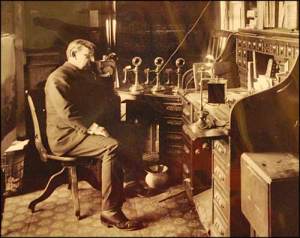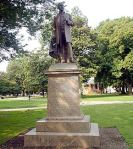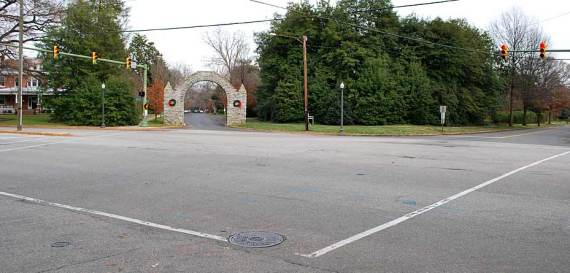 I’ve considered myself a Northsider for the past decade and have always been fascinated with the homes, architecture, retail, parks and especially the excellent urban forestry in the distinguished Richmond neighborhood.
I’ve considered myself a Northsider for the past decade and have always been fascinated with the homes, architecture, retail, parks and especially the excellent urban forestry in the distinguished Richmond neighborhood.
 Bill Martin, the director of the Valentine Richmond History Center, conducted a two-hour tour of the quaint, mostly middle class Bellevue neighborhood in Richmond’s Northside. At any given time, there were at least 60 people along for the walk, as neighbors joined or left the procession that followed at path from MacArthur Avenue to Bellevue Avenue to Seminary Avenue and back on Claremont Avenue.
Bill Martin, the director of the Valentine Richmond History Center, conducted a two-hour tour of the quaint, mostly middle class Bellevue neighborhood in Richmond’s Northside. At any given time, there were at least 60 people along for the walk, as neighbors joined or left the procession that followed at path from MacArthur Avenue to Bellevue Avenue to Seminary Avenue and back on Claremont Avenue.
Martin said Richmond is still living with the legacy from the 1890s when the city’s suburbs began to develop along the privately owned trolley lines that stretched into the Northside with neighborhoods like Ginter Park, Barton Heights and Highland Park. Development of the Fan District and Monument Avenue and areas south of the James with Woodland Heights and neighborhoods surrounding Forest Hill Park happened in this same period.
Many remnants of that period still exist, such as the concrete polls along Hermitage Road that were used 100 years ago to support the lighting and electric lines that powered the street cars.
 There are more than 1,000 dwellings in Bellevue, most of them single-family homes. Many were built in the 1920s and 30s, Martin said. He pointed out that these neighborhoods didn’t suffer economically with the rest of the nation during that time, saying “the Great Depression didn’t happen in Bellevue.”
There are more than 1,000 dwellings in Bellevue, most of them single-family homes. Many were built in the 1920s and 30s, Martin said. He pointed out that these neighborhoods didn’t suffer economically with the rest of the nation during that time, saying “the Great Depression didn’t happen in Bellevue.”
“It was a period of massive growth for Richmond as an industrial giant,” he said, noting that many of the homes in Bellevue were “smaller Craftsman-style homes” that fit the needs of the workers in Richmond’s factories and downtown industry.
Tobacco magnate and famed Richmond philanthropist Lewis Ginter is usually the first person most people associate with the creation of the Northside, but he died October 1, 1897, and wasn’t alive for most of the actual development and construction of the neighborhoods.
“Ginter was just like everyone else, speculating on real estate,” Martin said of Ginter’s interests in helping develop the Northside off the trolley line that ran from Richmond to Ashland on Brook Turnpike (now Brook Road). He added that Ginter was late to the party and missed on the big wave of development in that period of Richmond’s history.
 “People wanted to get out of downtown,” Martin said, suggesting that white flight and the desire to escape the hustle and bustle of urban living was the trend.
“People wanted to get out of downtown,” Martin said, suggesting that white flight and the desire to escape the hustle and bustle of urban living was the trend.
There was a large movement to erect parks and monuments to Confederate and civic heroes in Richmond in the 1890s and early 1900s, and the impetus for this was for them to be a draw to the suburbs.
Some of the key monuments erected in this time were General Robert E. Lee (1890) and Major General J.E.B. Stuart and Jefferson Davis (both 1907) on Monument Avenue. The Fan District saw monuments to General Williams Carter Wickham (1891) and the Richmond Howitzers monument (1892) and Church Hill gained the Confederate Soldiers and Sailors monument (1894).
Besides the monument to General A.P. Hill (1892) in the intersection of Laburnum Avenue and Hermitage Road, the Northside didn’t have many draws. Ginter’s created the Lakeside Wheel Club (near where Lewis Ginter Botanical Garden now sits), which brought in many people who could ride the trolley cars and spend the day biking and playing in Lakeside. He also provided land for the move of Union Theological Seminary to Richmond from Hampden-Sydney.
 The Northside escaped the destructive path of interstates 95 and 64 that cut off or bisected many other neighborhoods north of downtown — like Jackson Ward, Barton Heights and Highland Park. Jackson Ward, a historically influential and stable black neighborhood, lost 10 percent of its homes during that highway construction in the 1950s.
The Northside escaped the destructive path of interstates 95 and 64 that cut off or bisected many other neighborhoods north of downtown — like Jackson Ward, Barton Heights and Highland Park. Jackson Ward, a historically influential and stable black neighborhood, lost 10 percent of its homes during that highway construction in the 1950s.
“Transportation planning has long-term effects on our neighborhoods…Northside escaped relatively unharmed,” Martin said, adding that at one point the Interstate 95 was planned further east, through the heart of the area, but residents were able to fend it off.
Bellevue remains largely intact and has had little destruction or redevelopment in comparison to most Richmond neighborhoods.
Martin encouraged tour participants to chime in with their knowledge of the neighborhood and there were several funny comments along the trip. He got in a good jab, describing the treeless landscape of the Northside at the beginning of its huge period of growth around 1900.
“When you think of this neighborhood, there were no trees, no features…it was like being in Short Pump,” Martin said in his comparison, poking fun at current state of the unapologetic sprawl in that area of western Henrico County.
 He told another story about how MacArthur Avenue got its name. The city had to rename many streets to avoid duplication, and after going through many changes through the years, the avenue finally was renamed for World War II hero General Douglas MacArthur. That provided the opportunity for many people to “complain that Richmond wasted a good name” on such a small, relatively insignificant street.
He told another story about how MacArthur Avenue got its name. The city had to rename many streets to avoid duplication, and after going through many changes through the years, the avenue finally was renamed for World War II hero General Douglas MacArthur. That provided the opportunity for many people to “complain that Richmond wasted a good name” on such a small, relatively insignificant street.
Of course today, the street is still doing well, with a good variety of neighborhood shops and restaurants, including the well-know Dot’s Back Inn and Bellevue staples Stir Crazy Café, Once Upon a Vine and Zorba’s Pizza. There are several shops and restaurants around the corner on Bellevue Avenue as well.
“Part of the reason the neighborhood did well [as a developing suburb] was the access to modern retail,” Martin said, speaking about the former Azalea Mall and the dozens of neighborhood grocery stores (notably A&P) and small businesses that were dotted throughout the Northside.
 Another good tidbit came from a Bellevue resident who said she loved her “house with personality that new homes just don’t have.” She described her neighborhood as tight-knit and that everybody has always been so kind, friendly, helpful and generous.
Another good tidbit came from a Bellevue resident who said she loved her “house with personality that new homes just don’t have.” She described her neighborhood as tight-knit and that everybody has always been so kind, friendly, helpful and generous.
She told a story about a woman who moved on to her street and was quickly overwhelmed with the neighborly attitudes, bringing the woman to declare her feelings about Bellevue: “I thought I moved to Mayberry, but instead it is Nirvana.”
The Bellevue tour was the first I’ve taken with the Valentine Richmond History Center outside of the immediate downtown Richmond area and it was very worthwhile and informative. If you have interest in taking any of their wonderful tours, see www.richmondhistorycenter.com.
As for Bellevue, see this description from the City of Richmond website:
The Bellevue neighborhood extends north from Ginter Park to the city limits along Westbrook Avenue. Originally part of Henrico County, the area was annexed into the city in 1940. The houses in the community vary in size from small dwellings to spacious homes. Cottages and bungalows abound with many featuring large windows, wide porches and verandas. The architecture ranges from Italianate to Spanish with tile roofs to American Four Square. Roads lined with shade trees curve and meander through the neighborhood.
![]() WHAT: Fourth Police Precinct Project in Northside in Richmond, Virginia.
WHAT: Fourth Police Precinct Project in Northside in Richmond, Virginia.






 I consider the empty parking lot at Azalea Mall “suburban blight” and an environmental wasteland. I wish that it could be bulldozed and replaced by a park with nice trees and grass.
I consider the empty parking lot at Azalea Mall “suburban blight” and an environmental wasteland. I wish that it could be bulldozed and replaced by a park with nice trees and grass.









Comments & trackbacks